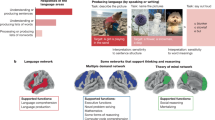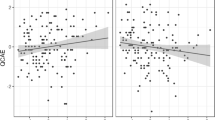Abstract
In the present study, we examined modulations of the second language (L2) positive emotion-label words, positive emotion-laden words, and neutral words on conflict processing in a flanker task. Twenty Chinese–English bilinguals were instructed to decide the color of the central words that were vertically surrounded by the same words with the same or different color. During the task, their cortical activation was recorded. The result showed that L2 positive emotion-laden words elicited different brain activations from emotion-label words and neutral words at both early and late stages. Differential modulations on conflict processing between positive emotion-label words and positive emotion-laden words in the L2 existed even after approach-motivation intensity was controlled. These results suggest emotion word type affects conflict processing, even in L2.



Similar content being viewed by others
Notes
One reviewer suggested that we should analyze the ERP data without erroneous trials. Therefore, the current results showed the data that excluded erroneous trials. However, we also attached the results with erroneous trials that can be found in Supplementary materials. The result pattern was totally unchanged, with some power and significance increase after excluding the incorrect trials.
References
Algom, D., Chajut, E., & Lev, S. (2004). A rational look at the emotional stroop phenomenon: A generic slowdown, not a stroop effect. Journal of Experimental Psychology: General, 133(3), 323.
Altarriba, J., & Basnight-Brown, D. M. (2011). The representation of emotion vs. emotion-laden words in English and Spanish in the Affective Simon Task. International Journal of Bilingualism, 15(3), 310–328.
Ayçiçegi-Dinn, A., & Caldwell-Harris, C. L. (2009). Emotion-memory effects in bilingual speakers: A levels-of-processing approach. Bilingualism: Language and Cognition, 12(03), 291–303.
Brysbaert, M., & New, B. (2009). Moving beyond Kučera and Francis: A critical evaluation of current word frequency norms and the introduction of a new and improved word frequency measure for American English. Behavior Research Methods, 41(4), 977–990.
Chen, P., Lin, J., Chen, B., Lu, C., & Guo, T. (2015). Processing emotional words in two languages with one brain: ERP and fMRI evidence from Chinese–English bilinguals. Cortex, 71, 34–48.
Citron, F. M. (2012). Neural correlates of written emotion word processing: A review of recent electrophysiological and hemodynamic neuroimaging studies. Brain and Language, 122(3), 211–226.
Colbeck, K. L., & Bowers, J. S. (2012). Blinded by taboo words in L1 but not L2. Emotion, 12(2), 217.
Conrad, M., Recio, G., & Jacobs, A. M. (2011). The time course of emotion effects in first and second language processing: A cross cultural ERP study with German–Spanish bilinguals. Frontiers in Psychology, 2, 351.
Delaney-Busch, N., Wilkie, G., & Kuperberg, G. (2016). Vivid: How valence and arousal influence word processing under different task demands. Cognitive, Affective, & Behavioral Neuroscience, 16(3), 415–432.
Delplanque, S., Silvert, L., Hot, P., Rigoulot, S., & Sequeira, H. (2006). Arousal and valence effects on event-related P3a and P3b during emotional categorization. International Journal of Psychophysiology, 60(3), 315–322.
Electrical Geodesics, I. (2003). Net station waveform tools technical manual. s-man-200-wtfr-001 (Technical Report): EGI.
Eriksen, B. A., & Eriksen, C. W. (1974). Effects of noise letters upon the identification of a target letter in a nonsearch task. Attention, Perception, & Psychophysics, 16(1), 143–149.
Frings, C., Englert, J., Wentura, D., & Bermeitinger, C. (2010). Decomposing the emotional Stroop effect. The Quarterly Journal of Experimental Psychology, 63(1), 42–49.
Gable, P. A., & Harmon-Jones, E. (2008). Approach-motivated positive affect reduces breadth of attention. Psychological Science, 19(5), 476–482.
Gao, S., Zika, O., Rogers, R. D., & Thierry, G. (2015). Second language feedback abolishes the “hot hand” effect during even-probability gambling. Journal of Neuroscience, 35(15), 5983–5989.
Iacozza, S., Costa, A., & Duñabeitia, J. A. (2017). What do your eyes reveal about your foreign language? Reading emotional sentences in a native and foreign language. PLoS ONE, 12(10), e0186027.
Imbir, K., Spustek, T., Bernatowicz, G., Duda, J., & Żygierewicz, J. (2017a). Two Aspects of activation: Arousal and subjective significance–behavioral and event-related potential correlates investigated by means of a modified emotional stroop task. Frontiers in Human Neuroscience, 11, 608.
Imbir, K. K., Jurkiewicz, G., Duda-Goławska, J., Pastwa, M., & Żygierewicz, J. (2018). The N400/FN400 and lateralized readiness potential neural correlates of valence and origin of words’ affective connotations in ambiguous task processing. Frontiers in Psychology, 9, 1981.
Imbir, K. K., Spustek, T., Duda, J., Bernatowicz, G., & Żygierewicz, J. (2017b). N450 and LPC event-related potential correlates of an Emotional Stroop Task with words differing in valence and emotional origin. Frontiers in Psychology, 8, 880.
Jankowiak, K., & Korpal, P. (2018). On modality effects in bilingual emotional language processing: Evidence from galvanic skin response. Journal of Psycholinguistic Research , 47(3), 663–677.
Jończyk, R. (2016). Affect-language interactions in native and non-native English speakers. Springer International Publishing AG.
Jończyk, R., Boutonnet, B., Musiał, K., Hoemann, K., & Thierry, G. (2016). The bilingual brain turns a blind eye to negative statements in the second language. Cognitive, Affective, & Behavioral Neuroscience, 16(3), 527–540.
Kanske, P., & Kotz, S. A. (2007). Concreteness in emotional words: ERP evidence from a hemifield study. Brain Research, 1148, 138–148.
Kanske, P., & Kotz, S. A. (2010). Modulation of early conflict processing: N200 responses to emotional words in a flanker task. Neuropsychologia, 48(12), 3661–3664.
Kanske, P., & Kotz, S. A. (2011). Conflict processing is modulated by positive emotion: ERP data from a flanker task. Behavioural Brain Research, 219(2), 382–386.
Kazanas, S. A., & Altarriba, J. (2015). The automatic activation of emotion and emotion-laden words: Evidence from a masked and unmasked priming paradigm. The American journal of Psychology, 128(3), 323–336.
Kazanas, S. A., & Altarriba, J. (2016a). Emotion word processing: Effects of word type and valence in Spanish–English bilinguals. Journal of Psycholinguistic Research, 45(2), 395–406.
Kazanas, S. A., & Altarriba, J. (2016b). Emotion word type and affective valence priming at a long stimulus onset asynchrony. Language and Speech, 59(3), 339–352.
Kazanas, S. A., McLean, J. S., & Altarriba, J. (2019). Emotion and emotion concepts: Processing and use in monolingual and bilingual speakers. In J. Schwieter & M. Paradis (Eds.), The Handbook of the Neuroscience of Multilingualism, 313–334.
Kissler, J., Herbert, C., Peyk, P., & Junghofer, M. (2007). Buzzwords early cortical responses to emotional words during reading. Psychological Science, 18(6), 475–480.
Kousaie, S., & Phillips, N. A. (2012). Conflict monitoring and resolution: Are two languages better than one? Evidence from reaction time and event-related brain potentials. Brain Research, 1446, 71–90.
Kutas, M., & Federmeier, K. D. (2011). Thirty years and counting: Finding meaning in the N400 component of the event-related brain potential (ERP). Annual Review of Psychology, 62, 621–647.
Larsen, R. J., Mercer, K. A., Balota, D. A., & Strube, M. J. (2008). Not all negative words slow down lexical decision and naming speed: Importance of word arousal. Emotion, 8(4), 445–452.
Lemhöfer, K., & Broersma, M. (2012). Introducing LexTALE: A quick and valid lexical test for advanced learners of English. Behavior Research Methods, 44(2), 325–343.
Li, W., Jiang, Z., Liu, Y., Wu, Q., Zhou, Z., Jorgensen, N., et al. (2014). Positive and negative emotions modulate attention allocation in color-flanker task processing: Evidence from event related potentials. Motivation and Emotion, 38(3), 451–461.
Lindquist, K. A., & Gendron, M. (2013). What’s in a word? Language constructs emotion perception. Emotion Review, 5(1), 66–71.
Liu, Y., Wang, Z., Quan, S., & Li, M. (2017). The effect of positive affect on conflict resolution: Modulated by approach-motivational intensity. Cognition and Emotion, 31(1), 69–82.
Martin, J. M., & Altarriba, J. (2017). Effects of valence on hemispheric specialization for emotion word processing. Language and Speech, 60(4), 597–613.
Opitz, B., & Degner, J. (2012). Emotionality in a second language: It’s a matter of time. Neuropsychologia, 50(8), 1961–1967.
Paap, K. R., Johnson, H. A., & Sawi, O. (2014). Are bilingual advantages dependent upon specific tasks or specific bilingual experiences? Journal of Cognitive Psychology, 26(6), 615–639.
Pavlenko, A. (2012). Affective processing in bilingual speakers: Disembodied cognition? International Journal of Psychology, 47(6), 405–428.
Pavlenko, A. (2017). Do you wish to waive your rights? Affect and decision-making in multilingual speakers. Current opinion in Psychology, 17, 74–78.
Ponari, M., Rodríguez-Cuadrado, S., Vinson, D., Fox, N., Costa, A., & Vigliocco, G. (2015). Processing advantage for emotional words in bilingual speakers. Emotion, 15(5), 644–652.
Roselli, M., Vélez-Uribe, I., & Ardila, A. (2017). Emotional associations of words in L1 and L2 in bilinguals. In A. Ardila, A. Cieślicka, R. Heredia, & M. Rosselli (Eds.), Psychology of bilingualism (pp. 39–72). Springer.
Schrauf, R. W., & Sanchez, J. (2004). The preponderance of negative emotion words in the emotion lexicon: A cross-generational and cross-linguistic study. Journal of Multilingual and Multicultural Development, 25(2–3), 266–284.
Sheikh, N. A., & Titone, D. (2016). The embodiment of emotional words in a second language: An eye-movement study. Cognition and Emotion, 30(3), 488–500.
Sutton, T. M., & Altarriba, J. (2008). Emotion words in the mental lexicon: A new look at the emotional Stroop effect. The Mental Lexicon, 3(1), 29–46.
Vinson, D., Ponari, M., & Vigliocco, G. (2014). How does emotional content affect lexical processing? Cognition and Emotion, 28(4), 737–746.
Voss, J. L., & Federmeier, K. D. (2011). FN400 potentials are functionally identical to N400 potentials and reflect semantic processing during recognition testing. Psychophysiology, 48(4), 532–546.
Warriner, A. B., Kuperman, V., & Brysbaert, M. (2013). Norms of valence, arousal, and dominance for 13,915 English lemmas. Behavior Research Methods, 45(4), 1191–1207.
Xue, S., Cui, J., Wang, K., Zhang, S., Qiu, J., & Luo, Y. (2013). Positive emotion modulates cognitive control: An event-related potentials study. Scandinavian Journal of Psychology, 54(2), 82–88.
Zhang, J., Teo, T., & Wu, C. (2018a). Emotion words modulate early conflict processing in a flanker task: Differentiating emotion-label words and emotion-laden words in second language. Language and Speech. https://doi.org/10.1177/0023830918807509.
Zhang, J., Wu, C., Meng, Y., & Yuan, Z. (2017). Different neural correlates of emotion-label words and emotion-laden words: An ERP study. Frontiers in Human Neuroscience, 11, 589. https://doi.org/10.3389/fnhum.2017.00455.
Zhang, J., Wu, C., Yuan, Z., & Meng, Y. (2018b). Different early and late processing of emotion-label words and emotion-laden words in second language: An ERP study. Second Language Research. https://doi.org/10.1177/0267658318804850.
Zinchenko, A., Kanske, P., Obermeier, C., Schröger, E., & Kotz, S. A. (2015). Emotion and goal-directed behavior: ERP evidence on cognitive and emotional conflict. Social Cognitive and Affective Neuroscience, 10(11), 1577–1587.
Zinchenko, A., Obermeier, C., Kanske, P., Schröger, E., & Kotz, S. A. (2017). Positive emotion impedes emotional but not cognitive conflict processing. Cognitive, Affective, & Behavioral Neuroscience, 17(3), 665–677.
Acknowledgements
This study was supported by MYRG2017-00217-FED, MYRG2016-00193-FED, and MYRG2015-00221-FED from the University of Macau in Macau. The authors would thank Kai Chen for his assistance on programming and data collection.
Author information
Authors and Affiliations
Corresponding author
Ethics declarations
Conflict of interest
The authors declare that they have no conflict of interest.
Additional information
Publisher’s Note
Springer Nature remains neutral with regard to jurisdictional claims in published maps and institutional affiliations.
Electronic supplementary material
Below is the link to the electronic supplementary material.
Rights and permissions
About this article
Cite this article
Wu, C., Zhang, J. Conflict Processing is Modulated by Positive Emotion Word Type in Second Language: An ERP Study. J Psycholinguist Res 48, 1203–1216 (2019). https://doi.org/10.1007/s10936-019-09653-y
Published:
Issue Date:
DOI: https://doi.org/10.1007/s10936-019-09653-y




